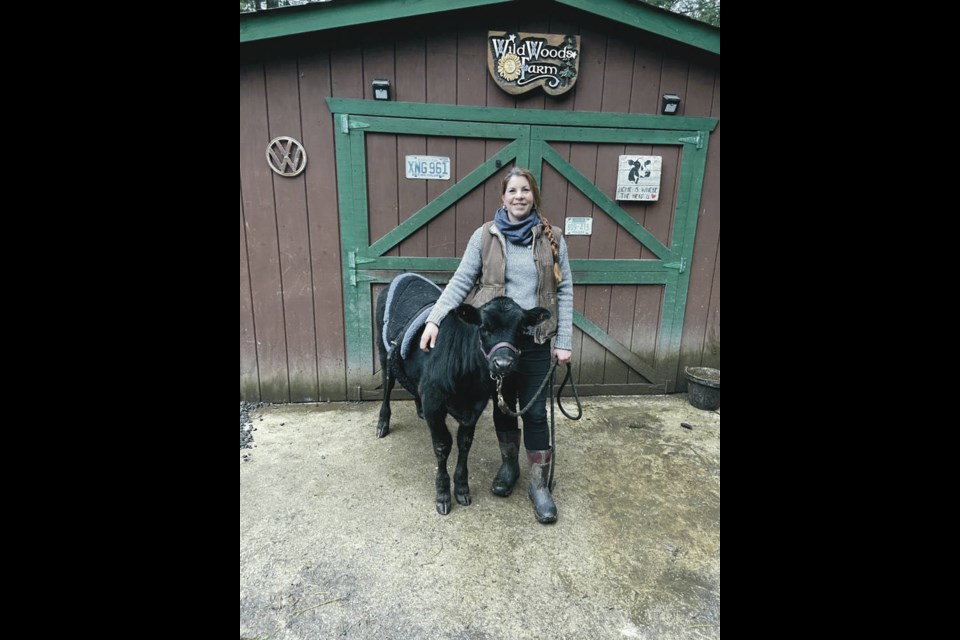On a small farm on an idyllic rural patch of Sooke near the Metchosin border, Kristy Sivorot is living the life of a modern pioneer.
She and her husband, Ron, along with their two young sons, have three dogs and numerous cats, and raise chickens, turkeys, ducks, pigs, goats and cattle on 7.6 acres of forest they partially cleared, fenced and seeded.
They produce their own milk, cream and cheese, and meat, and can vegetables from a large garden.
But there was something missing.
That’s where Moose, a steer born in early October, comes in.
Sivorot, who had horses when she was growing up on the outskirts of Winnipeg, is training Moose so she can ride him.
She figures if the immigrant pioneers did it, so can she.
Steers are, in fact, frequently used for trail riding and pulling carts in parts of Canada, the U.S., Europe and Asia. Humans have been riding cattle since the beasts were domesticated about 6,000 years ago.
So, giddy up.
“I thought: ‘Why not?’ … There are people who train and ride steers in lots of places, why not here?” said Sivorot.
Horses are expensive to keep and the terrain around the Sivorot’s property is rocky, confined and in some places steep. So her goal is to train Moose to ride the nearby Galloping Goose Trail around the Roche Cove area.
The transformation of Moose from ordinary steer to trusty mount is well underway.
Sivorot has halter-trained the young steer, the castrated offspring of her Holstein-Jersey milk cow and a Jersey bull.
She’s also starting the saddling process, first with blankets. A donated leather saddle from a farmer in Metchosin will come later as she adds weight to the steer’s back.
Riding will likely begin next year, as Moose grows and gains weight, probably up to 1,000 pounds. “I am working on making him bomb-proof,” Sivorot said.
“I walk him around our farm and he has been exposed to the dogs and cats, birds and children right from the start. I have flapped plastic bags at him and exposed him to other noises.
“He’s showing he’s a very gentle soul. But I have to get him out.”
Sivorot is looking for a small stock trailer so she can transport the young steer to area trails to give it more exposure, as well as the Metchosin Public Riding Ring, where she’s been invited to train Moose.
While horses are allowed on some sections of the Galloping Goose, there is nothing specific about cattle in the rules.
CRD spokeswoman Christiana Jones — fielding what she called “a first” when it comes to questions about the trail system — said cattle are not forbidden in areas that allow for horses, “but they do need to be under care and control and are not permitted to damage vegetation or to graze.”
Cattle would also be allowed in horse zones in 13 CRD parks.
For her part, Sivorot doesn’t think there’s much difference between a 1,000-pound horse and a 1,000-pound steer, as long as they are trained and on a lead. “I want to get [Moose] out there. If a bike’s coming, I want him to be OK. I feel the support is really there for the Galloping Goose in the Metchosin area.
“If I had 100 acres of land, I’d ride him there. I’m making do with what’s available.”
Sivorot is a student of Temple Grandin, an autistic woman who is a celebrated proponent for the humane treatment of livestock and the subject of a 2010 biopic starring Claire Danes. Her 2017 book, Working with Farm Animals, decodes animal behaviour in small-scale farming operations, describing their senses, fears, instincts and memories.
Moose fits all of the criteria for a good temperament, said Sivorot, including a theory about facial hair whorls. Grandin said a farrier’s study of the whorls in horses and cattle showed the animals with a whorl originating from a central position between the eyes were more docile than animals with a higher whorl.
Dr. Peter Watson, a veterinarian with Ag West Veterinary Group based in the Cowichan Valley, said Moose is certainly ridable.
“Generally, cows growing up in a backyard setting and handled a lot are capable of being ridden,” said Watson, who grew up in Metchosin and and still lives there. “Beef cattle on the range are a little more wild than a dairy cow, [which] is being handled and used to [human contact] every day.”
Watson has seen Moose only once since he was born but is convinced he will be a good pet and mount for Sivorot. He said he can’t wait to see Moose on the Galloping Goose.
“Credit to Kristy. She’s dedicated to the cause. She has what it takes to get a ridable cow,” said Watson.
When she isn’t tending the farm and home-schooling her sons, Bjorn, 5, and Griffin, 7, Sivorot works 12-hour weekend shifts as a nurse at Royal Jubilee Hospital, where she’s been on the front lines of the pandemic. Husband Ron works weekdays as general manager of Keena Metal in Langford.
“My husband says my animals, the farm, are my therapy,” said Sivorot. “When I have those heart-breaking moments at the hospital, when you lose someone, I can come home and feel happy with them.”



